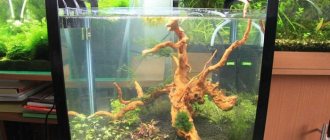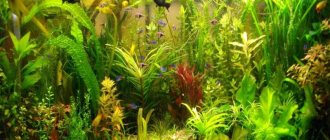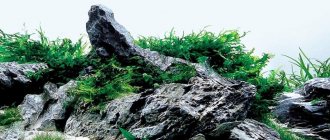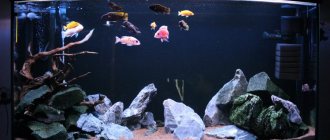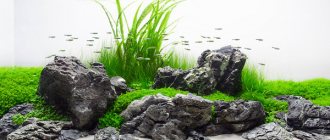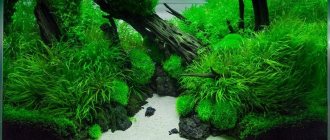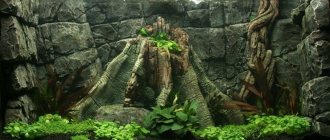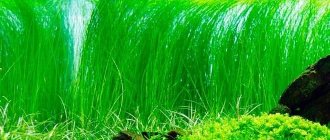Features of aquarium arrangement
Aquarium is one of the most popular hobbies of the world population.
It knows no borders, structures or ethnic conflicts. Exhibitions are held annually to demonstrate new fashion trends. World famous aquarium designers are working on it. The aquarium itself is a complex and closed ecosystem.
Features of the arrangement of a particular tank depend on the following factors:
- What is an aquarium for? Can be decorative, especially for spawning purposes.
- Where will it be located: apartment, office, exhibition center, etc.
- Fresh or sea water.
- What fish and plants are you going to populate the ship with?
- Much depends on the shape and size of the jar. They are rectangular, square, corner, round.
Design styles
A beautiful aquarium is a bright and memorable detail in the interior. Harmoniously designed, it looks luxurious in the apartment. There are several popular stylistic trends that will help transform it.
Pseudo-sea
The presented style of aquarium design does not require large expenses from the owner. To create a pseudo-marine environment, you will need to pour regular soil on the bottom of the aquarium and plant plants that do not require special care. As a backlight, it is better to use lamps with blue tones so that the water visually acquires a sea tint.
Seashells are used as additional elements to highlight the nautical theme, don't forget that corals and faux shells will help complete the design of this beauty.
The finished composition will delight the visiting guests; everyone will feel that they have really arrived at the depths of the sea. But in general, such aquariums are considered freshwater, so it is necessary to get fish that are suitable for this environment.
Dutch
A Dutch-style home aquarium is all about creating a realistic, deep design using greenery of different shapes and sizes. To make an interior for an aquarium in the Dutch style, you must adhere to the following rules:
- Living flora is planted in the container: low grasses and algae are located in front, flowers with large leaves are in the middle, and lush tall bushes are behind. This plan allows you to create a feeling of a three-dimensional natural background.
- Each plant is planted so that it occupies about 10 square meters. See Soils. This will make the planting dense, and at the same time the flowers will feel comfortable, grow and form a natural landscape.
- For Dutch tanks, plants of different colors are selected, combining reddish, green, light green and yellow tones.
- For such medium-sized aquariums, it is better to choose fish that are painted in bright and eye-catching colors.
Before you start decorating an aquarium in the Dutch style, you should keep in mind that such an aquarium will require constant care:
- Carbon dioxide supply.
- Vegetation pruning and fertilizing.
- Controlling the number of fish.
- Regular cleaning.
Japanese (natural)
Japanese style is one of the most beautiful and inspiring in the aquarium hobby. Its essence is to create an empty space filled with a certain meaning. There are four striking examples of Japanese-style aquarium design:
- Stone garden - natural stones are used for decoration, with the help of which they create figures with a mysterious meaning or beautiful compositions.
- Iwagumi - to create this aquarium design option, dwarf trees and figurines are used: boats, sunken ships and stones.
- Reboku - in this style, the emphasis is on large obstacles, which are complemented by natural stones.
- Wabi-kusa is a complex type of aquarium decoration that uses a protrusion of moss facing the surface of the water surface.
Plot
Decorating a home aquarium in a storytelling style will delight parents and lovers of cartoons and fairy tales. As the name suggests, the design is created according to a specific plot taken from films, books and fairy tales. The most popular tanks are designed in the style of “Nemo” and “The Little Mermaid”.
To bring everyone's favorite Little Mermaid scene to life in an aquarium, you'll need:
- A pair of multi-colored corals can be either real reefs or models made from safe materials.
- Starfish.
- Various spectacular and attractive projectiles.
- Underwater castle statue.
- Mermaid figurine.
- Tall algae sway spectacularly in the water.
An artificial tank, decorated in a theme style, looks great in a nursery.
Vanguard
The avant-garde style is non-standard. Fits well into unusual and bright rooms. Most often, artificial plants, unusual light, and brightly colored soil are used.
Disney
These are copies of popular cartoon scenes about Nemo and the Little Mermaid. Children's rooms are decorated with similar aquariums.
The landscapes are decorated with treasures, caves, plants, corals and castles made of synthetic materials. Fish and plants are chosen as bright as possible. Seashells can be exotic and intricate.
Herbalist
The design of freshwater aquariums is often done in the herbal style, which is divided into two subtypes:
- No Force – With this option, owners will plant plants in the tank without any trimming or leveling. As a result, the greenery grows on its own, which looks natural, like in nature.
- Forced - as in the first case, the viewer’s attention is focused on the underwater flora. The difference between a man-made aquarium and herbalists is that the plants are carefully cared for by providing fertilizer, pruning and carbon dioxide.
Pseudo-natural (pseudo-sea)
When designing aquariums in a pseudo-natural style, realistic landscapes are created that imitate a certain natural landscape:
- Rocky mountains and gorges.
- Bottom and forests.
- Lawns and architectural objects.
To achieve maximum realism, you need to pay attention to the little things: the right voluminous wallpaper that imitates a certain landscape and the characteristic decor of the chosen theme.
For example, nowadays it is especially popular to build sand cascades in an underwater aquarium, which requires fine white sand and a pump, under the influence of which the grains of sand rise through a pipe and then gracefully fall into a collection bowl. Likewise, you can create a pseudomora aquarium design that imitates a natural waterfall.
Collector's
One of the varieties of underwater garden. Requires a volume of 50 liters. The principle is this: available species of aquatic plants are used (out of 15 species), which are planted at the discretion of the author. Over time, they grow, penetrating each other's territory. It gives the impression of a neglected garden. To enliven the landscape, tall and low types of vegetation are combined.
This type is considered universal. Easily fits into any room design.
Creating a decorative background for an aquarium
The construction of a colorful aquaworld begins with the background design of the back wall of the aquarium. For fish it does not play a special role, but for others it acts as an integral part of a harmonious composition. There are different design approaches: imitation of rocks, coral clusters, thickened algae.
Decor for an aquarium with vegetation
Aquarium decor figurine
Decor for an aquarium with pebbles
Coconut aquarium decor
Here we focus on personal taste preferences. Some people like it bright, others like it dark. Due to the completely black background, visual depth of the water space is achieved, which is associated with the underwater oceanic world. Richer and lighter tones evoke thoughts of the lake.
Wild landscape
Aquarium decor
Decor for an aquarium with fry
Quartz aquarium decor
Types of decoration for the back wall of the aquarium:
- complete painting in a specific color scheme with the application of surface patterns on a marine or any other theme;
- decoration with self-adhesive multi-colored film;
- fixing foam sheets.
When gluing the film, it is important to degrease the glass first so that the material does not fall off. Then spray the surface with water from a spray device, apply the film evenly and progressively smooth it so that the air comes out.
Dutch style aquarium
Large aquarium decor
Concrete aquarium decor
Decor for an aquarium with a ship
Imitating a rocky bottom using foam plastic sheets involves burning the surface on one side (until bubbles form). After cooling, the abrasive is treated with liquid clay or cement. The result is a voluminous relief similar to coral reefs. It is fixed with tape to the rear inner wall of the aquarium.
Pirate themed aquarium decor
Wooden aquarium decor
Decor for aquarium palm trees
White marble aquarium soil
Which room should I place the aquarium in?
It is best to place the item in a room where dimensions allow. Most often, the living room or bedroom is chosen for it. But you may also prefer other places. An artificial pond will look good in any room if you choose the right shape and style.
Think about where you can place the aquarium in your apartment so that it matches the design.
Living room
This is a classic option for installing an artificial tank. All family members gather in the living room. The container can be placed in a special niche or on a cabinet designed for this purpose. There are built-in models and those that can be used as a coffee table.
In small living rooms, an aquarium can serve as a partition. In this case, narrow but tall options are usually chosen.
Kitchen
A small item is usually placed in the kitchen. It will help give coziness and comfort to a room where people spend a lot of time. If the kitchen is large and there is a separate dining area, you can equip a large aquarium.
In this case, it will act as a partition, with the help of which the space is zoned.
Bedroom
To decorate the sleeping area, small or medium-sized models with a laconic style are usually chosen. The corner of the aquarium should correspond to the calm atmosphere of the bedroom and help a person relax. Therefore, it is not at all necessary to buy bright fish or frilly and flashy things.
A dry or imitation aquarium can be a good alternative.
Hall
If the size of the corridors allows you to install an artificial pond, then this is worth doing. The hall will be significantly transformed. Large built-in items with lighting and other decorative elements look better.
Bathroom
An interesting solution would be to install an aquarium in the bathroom. A correctly selected model will fit perfectly into the interior and make it complete. To do this, they usually choose small items installed in open cabinets, on cabinets and built into niches.
It is not recommended to place it on its side, as there is a risk of the structure tipping over. The frame must be very strong.
Children's
If you are planning installation in this particular room, you need to weigh the pros and cons. On the one hand, the child will be interested in looking at the fish and learning about the world around him. On the other hand, children are careless, so they can accidentally damage or drop the container (if it is small). It is recommended to install an aquarium in the bedroom when the child grows up a little.
The objects are usually equipped with safe life support systems and are also built into an alcove or wall for protection against falls.
Other suitable room options
These are the basic ideas on where to put the aquarium. It can also be placed on the stairs (if we are talking about a private house), between the flights. The choice of premises will depend only on the wishes and preferences of the owner.
If the installation takes place in a studio, the objects most often serve as decorative partitions that zone the room.
What can be used as aquarium decor?
A properly designed indoor pond appears cohesive and cohesive. The aquarium is the central element of the interior, so the composition should not go beyond the design of the room. Furniture must be disinfected before use.
Underwater figures
Underwater figurines are one of the most fun ways to decorate your aquarium. Their placement requires free space and will somewhat complicate the cleaning process, but with their help you can create interesting compositions.
When choosing underwater figurines, you need to pay attention to what they are made of. If these are natural materials such as wood or stone, they must be sterilized. If it's plastic, make sure it doesn't leach dangerous chemicals into the water. The figures must be made of HDP, HDPE and LDPE plastic.
The breed of fish living in the aquarium is also taken into account. Some of them need a private refuge, others need more space.
Aquarium background
Another easy way to decorate that you can also DIY is an aquarium backdrop. This can be ordinary self-adhesive paper, which is applied to the outer back wall, or a three-dimensional texture imitating stones and corals, which is fixed inside the aquarium.
Wallpaper mainly helps to successfully hide equipment, filters and wires from the lamp to the eyes. But beyond this, its color and texture create the final image of the aquarium. In this case, you should give preference to a simple and unobtrusive background if the decor and inhabitants of the aquarium are bright and vibrant. If you want to diversify the look of the aquarium, choose a bright background.
Also think about the design of the room in which the aquarium will be located. If the interior is neutral, a bright background and the aquarium itself can become an interesting accent. If the room already has enough decoration, it is better to give preference to a calm design or think carefully about the combination of colors and details.
Corals and anemones
These invertebrates create an exotic and unique atmosphere. They require careful care and a large aquarium of at least 200 liters and are therefore suitable for experienced aquarists.
Corals have a hard skeleton and require constant water filtration. Home aquariums use corals that live in symbiosis with algae and do not require special nutrition. These include dendronephthia, gorgonium and clavicle.
When choosing coral, remember that only herbivorous fish that do not want to include it in their diet can live with it.
Anemones are a subspecies of corals that do not have a skeleton and are attached to the bottom using a suction cup. The most unpretentious anemones for decorating an aquarium are horse anemones, bubble anemones and carpet anemones.
Priming
The substrate is the main decorative element of the aquarium, especially if there is no room for figurines or corals. The bright bottom attracts attention and allows algae to grow. In addition, it is home to microorganisms that process organic matter and purify water.
The relief can be natural or artificial. Pebbles, sand, natural shells; artificial - stones and balls made of plastic or glass.
Before placing it in the aquarium, prepare the soil. If sand and pebbles were collected in nature, they are washed and foreign impurities and algae are removed. The sand is also passed through a fine sieve. It is recommended to boil any soil, even purchased soil, before use.
Before shaping the bottom, make sure the rocks are smooth and have no sharp edges to prevent the fish from getting hurt.
Artificial lawn purchased from a pet store has a number of advantages. It is fish safe, easy to care for, and comes in a variety of colors.
Stones
Decorating your aquarium with rocks is an easy way to create a natural and harmonious look. Specialized stores have a huge assortment of artificial stones for every taste and color, but mannequins cannot be compared with natural minerals.
When choosing stones, it is important to pay attention to the composition, since some types of stones are dangerous for the inhabitants of the pool. When decorating a stone garden, choosing quartz, granite and basalt is considered an excellent solution.
Live algae
Cabomba, hornwort, ammonia and rotala algae look very impressive in an aquarium. All of them easily take root in natural and artificial soils, do not require special care and turn the aquarium into an underwater forest. By releasing oxygen, they absorb excess carbon dioxide and make the water in the aquarium cleaner.
Artificial algae
Such algae have their own advantages. Clear advantages include cost-effectiveness and durability. They are indispensable in aquariums where fish feed not only on food, but also on plants. In addition, they do not grow and do not require weeding.
driftwood
You can choose driftwood from the forest and cook it yourself. The literature contains a description of how to select, boil and prepare obstacles for an aquarium. This is a very popular decorative element that adds a special touch to the seascape. Some fish enjoy chopping wood, adding variety to their diet.
But you can also buy it. The most popular is mangrove. This tree is popular because it does not rot, does not float, and has a beautiful structure and color. Harmless to fish.
Other types of decor
In addition to the decorative elements described above, there are many other options.
Available for sale:
- Caves: barrels, flowerpots, vases, moss shelter decorations, mink, vases.
- Castles, fortresses, ships, anchors, artificial forests.
- Figures: stars, octopuses, jellyfish, volcanoes, mushrooms, figurines.
To make your own jewelry, you can use regular foam.
Scheme of working with it:
- A castle, rock, stone is cut out of a piece of foam plastic.
- Cook on the front side until small bubbles appear.
- While the surface is warm, cement, alabaster or plaster is applied.
- Wait until the surface is completely dry and paint with gold or gray paint.
- Attaches to the front of the aquarium.
Making “treasures” from pebbles.
These interesting interior details can be made from ordinary stones collected on the beach:
- Select small stones of the same size and round shape.
- The required drawing is selected in advance.
- The pebbles are glued according to the template using silicone glue.
This creates caves, bridges, castles and fortresses. If it is difficult to choose the shape of an object on your own, then on the Internet you can always find a working example and a step-by-step implementation diagram. Glass beads are suitable for decoration. Some craftsmen even manage to make decorative pearls.
Lighting
Lighting in the aquarium is mandatory, as without it the fish will be stressed. However, lighting in a pond can not only imitate sunlight in nature, but also harmoniously complement the chosen style. By playing with shadows and the placement of light bulbs, you can create an extraordinary spectacle that will not leave viewers indifferent.
How to decorate an aquarium correctly?
Design planning
Before you buy anything, draw and write a plan of how you will decorate the aquarium. Think about what you want to see in the aquarium - fish, plants, decor. Choose the dimensions of the aquarium and technical equipment in accordance with your plan. Use reference materials to understand how realistic it is to implement your plans.
Decide in advance where you will place the aquarium. Choose a dark but easily visible area in your home. The aquarium will need to be cleaned, maintained - it should be possible to approach it from different sides.
Do not place the aquarium near a window or near a radiator. To maintain the health of its inhabitants, daylight in an aquarium should last 8-12 hours. Excessive light will provoke the growth of algae, then your efforts to decorate the aquarium will be in vain. And the battery will be a constant source of additional heat, which can cause overheating of the water, disrupting the balance of the ecosystem.
The more plants and fish you want to have, the larger their home should be. Experts advise paying attention to aquariums with a volume of 50 to 120 liters - sufficient volume for a variety of flora and fauna. Plants should have room in the water even when they grow a little. Decorations should not block plants from light. Decorations are designed not only to please the eye, but also to provide shelter for fish. The more detailed you plan how to decorate your home aquarium, the fewer difficulties will arise in the future.
You also need to choose what type of aquarium you want - freshwater or saltwater. We decided to focus on tips for decorating a freshwater aquarium, since this is usually where aquarists start. A freshwater aquarium will be a more budget-friendly option and will give you the necessary experience in regularly caring for your aquarium.
Choosing soil
The soil affects the overall appearance of the aquarium, but it is not only decoration, but also the foundation of the home of underwater flora and fauna. The soil covers and nourishes the roots of plants. Over time, beneficial bacteria settle in it, which process the waste products of the inhabitants of your underwater world. Aquarists advise choosing between pebbles and sand in favor of sand, since, for example, uneaten fish food can get under the pebbles and begin to rot. Painted soil lacks porosity; there will not be enough beneficial bacteria in it. Marble chips increase water hardness. Consider the habits of the future inhabitants of the aquarium. If the fish lives at the bottom and buries itself in the ground, then it needs fine sand.
The choice of soil for plants depends on how large their roots are. The soil for aquarium flora should be light and sloping. Fine or medium grain is usually suitable. Before placing it in the aquarium, the soil must be washed with water, without soap or any detergents.
Underwater castles and picturesque driftwood
The stones are perfect for decorating an aquarium; under water they become bright and their patterns are better visible. How can you decorate an aquarium with stones? Buy single stones or entire compositions, grottoes, castles. Such decor will not only add zest to the design, but will also serve as a shelter for fish.
Granite, basalt, quartz, syenite, flint are suitable for an aquarium - they do not change the composition of the water.
We do not recommend decorating the aquad with stones that you found on a river or lake, as well as pebbles, shells, etc. collected from the sea. You do not know their chemical composition and cannot guarantee that they will not degrade the water quality in your aquarium. If you purchased the stone from a specialized store, you can simply wash it with water and a brush.
Choose decor with neat, smooth edges so that the fish don’t get hurt when swimming by.
No matter how attractive the option of making your own aquarium decoration may seem, give preference to branded decor from the store. Doekor, made according to standards from safe materials, is a guarantee of quality and safety of a healthy aquarium ecosystem.
The snag will also become a spectacular decoration of a corner of nature; its appearance under water will resemble the shore of a reservoir. Pet stores have a wide selection of beautiful driftwood with curls. Mostly, mangrove driftwood and African (iron) Mopani wood are sold to decorate aquariums. They are made specifically for decorating aquariums, are sold already processed, practically do not color the water and do not affect the water parameters in the aquarium, do not rot in water, sink well and are easy to use. Before use, they must be washed and checked for buoyancy in a basin or bathtub. Do not place wooden decorations in the aquarium as a spacer. Glass walls can crack under the pressure of water-swollen wood. Secure the driftwood to the board, weigh it down with stones, and sprinkle with soil.
If you see a beautiful tree root while walking, do not rush to take it home and place it in an aquarium. Wood absorbs substances from the environment. Is it worth risking the well-being of the inhabitants of the aquarium for the sake of driftwood from the street?
Smooth glass objects are suitable for decorating an aquarium, but choose glass that has already been colored and not painted afterwards. Otherwise, the paint will partially dissolve in the aquarium water.
A clay jug or cup will go well with the underwater landscape. But buy a new clay product. Clay is a naturally porous material, so particles of detergents or fertilizers may remain in dishes and flower pots.
Shells look impressive, but they increase water hardness and should be discarded. But you can take a closer look at jewelry made of rubber and plastic. They are often used to make artificial plants for aquariums. They will not harm the environment of the aquadome; moreover, they can easily be “transplanted” to another corner of the composition. If you purchased plastic aquarium decorations from a pet store that are approved for use by young children, you can safely use them for your underwater landscape.
Don't go overboard with the decor. Remember that underwater plants need somewhere to spread their leaves, and fish need to swim.
Living plants
Many people are close to the point of view that an aquarium is precisely a corner of wildlife. I would like to fill it with living plants, not plastic decorations. Live plants will certainly give your aquarium a natural, natural look, but only if you care for them correctly and systematically. If the future owner does not have the time and opportunity to care for living plants, we recommend considering artificial plants. Nowadays there is a wide variety of them in pet stores, and their appearance is often almost as good as living ones.
It is not difficult to find information about different types of plants, choose the one you like and clarify the requirements for caring for it. Cryptocorynes, unpretentious bush plants, are popular among aquarists. Java moss is also loved for its unpretentiousness and rapid growth. It is enough to fix Java moss on the ground or driftwood.
For plants with stems and leaves, they should be planted in the ground according to the natural growth of the roots. In some plants they are arranged like a fan, in others they go vertically down. It is better to first make the hole for planting deeper. If necessary, the plant can be slightly pulled up. The main thing is that the roots do not need to be crumpled, they should be freely located in the soil.
Plants also need to be prepared for placement in the aquarium. Clean them from dried areas, rinse them in a solution of hydrogen peroxide, dissolving a teaspoon of peroxide in a liter of water. Rinse with water and trim the roots.
Collecting all the pieces of the puzzle
If you have decided how to decorate your home aquarium, it's time to turn all the elements into a single picturesque picture. All parts of the aquarium decor, from the aquarium itself to the tiny plants, need to be washed before installation. Lay the soil on the bottom in an even layer five to seven centimeters thick. Install decorative elements. Partially fill the volume with prepared aquarium water.
Plant the plants. Start with the largest and fluffiest ones, decorate with them the area closer to the back wall of the aquarium. Continue planting, moving towards the front of the bottom of the aquarium. To plant the most delicate herbaceous shoots in the foreground, you can use a special fork.
Add the remaining water, install and turn on all the necessary equipment - filter, lighting, and so on. Aquarists advise waiting a month before populating the aquarium with fish. During this time, the soil, plants and other components of your new corner of wildlife will form a full-fledged ecosystem in which the fish can easily adapt.
The passion for decorating aquariums can seriously take over you. Aquascaping, the art of creating beautiful landscapes in an aquarium, is now very popular. For enthusiasts of this trend, there are thematic exhibitions and competitions. But the main thing is that the design of the underwater kingdom is to your liking. We hope that a beautifully designed aquarium will delight you day after day.
Choosing an artificial reservoir model
Setting up an aquarium for fish always begins with choosing the container itself. It is better for novice aquarists to give preference to small containers - 60-100 liters in volume, since large aquariums are much more difficult to care for. The best shape for an aquarium is a rectangle or square, which will be comfortable for both fish and vegetation.
Other forms of aquariums look more original and unusual, for example, round aquariums or glass aquariums, but it should be borne in mind that organizing an aquarium of such forms is more complex and time-consuming, and besides, pets will feel uncomfortable in them.
Experienced aquarists recommend considering the following points before setting up a home aquarium:
- the number and types of fish that the owner wants to put in the aquarium;
- desired types of flora;
- equipment.
You can also make a tank yourself. To do this, you will need to purchase the necessary materials, study the technology, and then cover the aquarium with your own hands.
Decorating with stones
Many fish, such as African cichlids, like to hide and need places to hide. For these purposes, decorations are made from stones in the aquarium. But one should take into account the fact that some stones, such as limestone, marble, tuff, sandstone, release calcium salts into the water and make it hard.
The stones in the aquarium are either simply arranged beautifully, or they are used to make various slides and grottoes.
If you decide to place stones using the aquascape technique, then it is better to choose uneven, textured and preferably dark ones. Stones without marks and with smooth smooth edges look unnatural. The porous texture of the stones will create unnecessary shadows.
The stones should not be the same size on the ground, otherwise they will merge.
In order for the aquarium to imitate a corner of the waters of the wild, you should avoid too flat, even ground. It can only be level at the front wall, so as not to draw attention away from the decoration.
Pebble house
Rounded pebbles do not affect the quality of water in any way, therefore they are very popular among aquarists who make decorations for their aquariums with their own hands.
Any work begins with measurements. The size of the grotto should be such that there is a distance from it to the front and rear windows, then the fish that are fleeing persecution will be able to swim out of the grotto from both sides.
You should never make one entrance to the house so that the fish are locked there.
Step-by-step instruction:
- Tubes are rolled out of landscape paper, which will be the openings of the grotto.
- The foundation is being formed. To do this, the flattest and widest stones are laid out in a row with a gradual rounding. It is better that the stones are the same in height.
- Paper tubes are placed between the stones to mark the entrance to the grotto.
- To create an empty space inside the grotto, a wad of paper or cellophane wrapped with tape is placed in the center of the circle of stones.
- The second level of stones and all subsequent ones are placed on glue (silicone sealant) to the desired height.
- After the walls of the slide are ready, a flat pebble is placed on a ball of paper - this is the base of the roof from the inside.
- The stones connecting the walls and the base of the roof are glued.
The grotto is ready.
You can insert small snags into the resulting holes between the pebbles or, after drying, plant plants, for example, Thai fern. This will make the grotto in the aquarium more natural.
Silicone on the slide can be masked with small pebbles or sand.
The grotto is kept for two days, then the tubes can be removed from it.
It is better to place heavy grottoes not on the ground itself, but on a plexiglass substrate; for this you may even need to clear a place at the bottom. If a pebble of aquarium soil gets under a heavy mainsail, it can cause a point stress in the bottom glass and it will crack.
Universal mainsail (simple option)
Before starting work, you need to have a clear idea of what the finished decoration will look like. It’s better to draw it to know exactly how many and what shapes of planes will be needed.
To make it you will need:
- expanded clay;
- water;
- cement;
- sand;
- polyethylene.
Manufacturing stages:
- Cement and sand are mixed in a ratio of 3:1.
- Expanded clay is covered with a cement-sand mixture, filled with water and mixed. The consistency should be such that each granule is in the cement, but does not sink in it. This is necessary so that the homemade decoration has a pronounced relief.
- Cellophane (cling film) is spread on a flat surface, the resulting mass is laid out on it, and blanks are formed: a base with two columns (2 pieces) and a separate flat part in the shape of an oval or rectangle, which will be attached to the columns.
- The blanks must be covered with cellophane on top, otherwise the cement will be brittle.
- After the figures have dried, a fresh solution of cement and sand is prepared in the same proportions. It is applied to the tops of the dried columns of one of the blanks and the flat part is placed on them. The second workpiece is already attached to the resulting platform with columns down. The joints are secured with cement.
The result is a relief textured grotto in three tiers. The structure should be placed in water for a week to remove excess alkali from the cement.
Such blanks can be of any shape and size. And due to the fact that the bottom is smooth, they can be used as a background by pasting over the back wall.
See how to make a small aquarium grower:
Aquascaping Ideas
- An aquarium with large objects and large inhabitants.
- Minimalistic style.
- Use of corals.
- Use of luminescent parts.
- Make a hole in the wall.
For 50 liters
A small 50 liter freshwater aquarium will be a good preparation before purchasing larger aquariums. Such a volume is easy to care for, it is easier to provide the necessary conditions and install aeration and filtration systems.
Slow-growing plants take root well in such a space, but it is not recommended to plant fast-growing plants; they require frequent pruning of overgrown parts.
Not all types of fish can live in a space of 50 liters, only small and medium-sized ones. For example, swords, guppies, zebrafish, molynesia. There is not enough space for larger species.
Per 100 liters
a volume of 100 liters is the most convenient volume for creativity and a quiet life for fish of different sizes. With a 100-gallon home aquarium, you can create a garden with plenty of accents or a minimalist habitat for your pets. Both small and fairly large fish get along well.
For example, goldfish, discus, gourami, scalar.
For 200 liters
The 200-liter container looks good with a nautical design. You can use large elements: large stone blocks, driftwood and long branches, plants with large leaves. But such a design is difficult to create with your own hands without special knowledge and equipment.
Usually inhabited by large inhabitants of sea or ocean waters. For example, a predatory fish will feel good.
Recommended vegetation for an aquarium
Plant decor plays a significant role in creating the overall composition, enriches the environment with air and serves as additional feeding for the fish. These can be natural plants or artificial ones.
The last option is convenient in terms of care:
- easy to clean from algae deposits;
- always beautiful;
- neutral to water composition;
- do not attract fish (in terms of food).
It is more rational to combine living and artificial plants (flowers), which will enrich the landscape and maintain biobalance. Thus, some fish species spawn on algae.
Magnificent floral decor
Aquarium decor volcano
Aquarium decor grotto
Aquarium accessories
When planting vegetation, adhere to the basic principles:
- the foreground is decorated with low-growing specimens and grass;
- the back and side walls are filled with long algae and lush plants;
- Spreading bushes are planted in the middle.
It is recommended to combine plants not only by leaf size and stem growth, but also by color scheme. Due to this, the impression of a multi-tiered landscape appears, imitating a wild water landscape.
Aquarium decor with stones and corals
Aquarium decoration
Decor for aquarium boulders
Decor for an aquarium with corals
How to install an aquarium at home yourself
Creating a home artificial tank with your own hands is a responsible and complex process, but quite doable if you follow the rules and recommendations of experienced owners.
Organizing an aquarium at home for beginners includes several stages, the most important of which are the following points: choosing an aquarium model and the necessary aquarium equipment for the normal functioning of the artificial tank.
Rules for designing an aquarium
Before you set up an aquarium, you need to carefully consider the decor and purchase the necessary materials. Only after this does he begin to create a unique corner of the water world.
Please note the procedure when registering:
- Spread the soil at the bottom of the container using a special plastic trowel. Usually it is laid in several layers: sand, then coarse and medium gravel.
- Bacterial cultures for plants are scattered. This is a special nutritional layer.
- Places where bulky and heavy objects are planned should be decorated with foam.
- The background is being formed. An outer film is applied or artificial decorations are installed.
- Interior Design. Stones were laid out, scaffolding and decorations were installed. Plants have been planted.
- Filling with water. It is recommended to place a flat plate under it so that the stream of water does not wash away the ground and spoil the design of the aquarium.
- During the first two days, the functionality of the equipment and the integrity of the packaging are checked.
- The first inhabitants were released: snails and shrimps.
- Within a week or two, a biological balance is established. The water becomes cloudy, then becomes clear.
- You can throw the fish.
Equipment
No body of water can exist for a long time without the technical equipment necessary to care for the aquarium and provide comfortable living conditions for fish and plants. You can install equipment for an aquarium with your own hands by following the simple instructions on the packaging of the equipment, but to do this you need to know what technical devices you need to buy. So, before equipping an aquarium, you should choose the following devices in the store:
- filter;
- aerator;
- heater;
- thermometer;
- lighting.
This is a minimum list of what every aquarium needs. Models of devices are selected taking into account the needs of future residents and the size of the tank. In addition to equipment, don’t forget to buy tank care items:
- networks;
- sponges for washing dishes;
- sedimentation tanks for fish;
- a lid or glass to cover the container; you can even make a lid for the aquarium with your own hands;
- glass scraper.
Having purchased the necessary equipment, you should not install it right away - first you need to take care of the soil.
Snails
At least two weeks must pass before the aquarium is launched. After 7 days, sowing of the hardiest pets is allowed - ampoule snails and unpretentious plants that contribute to faster development of the ecosystem. Based on their feelings, it is easy to understand whether your simple aquarium is ready to accept the next batch of inhabitants.
Fish
After five to six days, having completed the necessary measurements and tests and making sure that the water indicators are acceptable for life, you need to move on to the last stage. The last and most enjoyable stage of creating an aquarium is the selection and arrangement of fish and crustaceans. Beginning aquarists setting up an aquarium for the first time should opt for unpretentious and bright phenotypes, for example:
- catfish;
- guppy;
- neon;
- swords;
- zebrafish;
- gourami;
- scalars;
- cockerels.
The number of pets depends on the size of the aquarium and the fish. It should also be remembered that not all species get along well, so selecting neighbors for a species aquarium is necessary taking into account the compatibility of the fish.
Setting up an aquarium is a responsible process that requires compliance with rules and recommendations. After choosing the necessary equipment and starting the artificial tank, do not forget to take care of the pets and greenery by keeping the aquarium clean and tidy.
Selecting suitable soil
Soil is especially important for plant decoration; it provides support for the roots. When choosing a material, adhere to the following conditions: do not harm the fish. Many representatives of the underwater world love to dig at the bottom or swallow pebbles. The main thing is that they do not get injured or choke. The color range of the soil is important for shellfish and shrimp.
Aquarium background decor
Aquarium decor spongebob
Decor for an aquarium in the living room
Clay aquarium decor
The chemical composition of the bottom design plays an important role. Some materials increase water hardness, which is not suitable for all fish and plants. It is ideal to fill with coarse-grained clean sand, expanded clay or gravel chips (fraction up to 4 mm).
Aquarium decor
Decorative tree for aquarium
Artificial aquarium decor
Decor for aquarium shells
If you decorate the aquarium in a green style, with a large inclusion of algae and other plants, then it is preferable to decorate the bottom with a nutritional composition. It is sold ready-made or mixed independently from sand, garden soil and clay.
Aquarium decor in the form of a steering wheel
Aquarium soil
Decorative grotto for an aquarium
Decor for an aquarium with algae
Useful tips
To make it easier for beginners, you should pay attention to a number of useful tips from experienced professionals. They are simple, but will help to avoid many problems both at the initial stages and in the future.
When choosing, filling and decorating an aquarium, you need to consider:
- If your room is small, a square aquarium is best. It can be placed in a corner or even in the center of the room.
- Living room. A tank of a specific design will suit you best. There are options without fish, only with decorative elements.
- The ecosystem of large ships is more stable than small ones.
- Do not use chemicals when cleaning your aquarium. Hot water with vinegar is best.
- Instead of a soil shovel, you can use a cut-out plastic bottle.
- Sometimes interesting objects are fixed on the walls or at the bottom. Silicone glue is used for this.
- The ground is laid out with a slight slope. To prevent it from moving, it is recommended to reinforce it with plastic terraces or stones.
- Natural shells cannot be used for decoration. Due to the large amount of calcium released into the water, its composition and hardness changes.
- Choose safe materials to decorate your aquarium.
- Jewelry made from alkaline materials is prohibited. They change the chemical composition of the water. Make it unfit for fish.
- When choosing stones, you should avoid sharp edges. They can harm the fish.
- The round jar does not require a background.
- To lay the soil in colored stripes, just insert sheets of cardboard between them as limiters, and then remove them.
- It is important to choose the right plants. Sometimes a few inexpensive popular species are enough to fill a pond in an original way.
- Some plants with strong root systems are best planted in clay pots or containers with nutrient soil. In the future, the decorative design will not deteriorate, and the plant can be easily removed and rearranged.
- To make the fish brighter, a darker shade of soil is recommended.
- Oak wood is not recommended; this tree colors the water.
- Do-it-yourself stones and shells must be boiled for 5-10 minutes to disinfect before placing them in a container.
- Separate parts of the aquarium, as well as plants such as moss, are attached to transparent fishing lines or clips.
- you need to select the fish you want to buy in advance. Find out all about the features of their content. Only stay with species that get along well and have similar conditions.
- After purchasing the fish, you must spend a week in quarantine in a separate aquarium. This is done so as not to infect it and not destroy the rest of the inhabitants.
- Figurines, amphorae, monuments and castles placed in an aquarium need regular cleaning.
- Water parameters should be constantly measured and maintained.
- When choosing an aquarium and arranging it, be sure to consider ease of care. Please remember that cleaning, scrubbing, and changing water can be time consuming. Otherwise, the reservoir risks turning into a swamp.
Pipe shelters
A simple, inexpensive and quick way is to make shelters for the inhabitants of the aquarium from plumbing polypropylene pipes.
The diameter of the pipes is selected depending on the size of the aquarium, fish, and the wishes of the owner.
Manufacturing stages:
- Cut the pipes to the required length.
- Prepare multi-colored small pebbles (soil).
- Carefully lubricate polypropylene blanks with silicone sealant.
- Place the pipe vertically in a container with soil and sprinkle it generously with pebbles. The dishes should be such that you can roll the tubes like a rolling pin with pressure for thorough gluing.
The product is allowed to dry and placed horizontally on the bottom of the aquarium.
Newbie mistakes
The mistakes of novice aquarists often come down to untimely cleaning of the reservoir, careless attitude to its internal and external changes, insufficient knowledge of the habitat and norms of behavior of pets. Below is a list of common errors.
- Wrong start again fish. Aquarium fish are placed only after the artificial tank has stabilized. Individuals purchased for acclimatization are first placed in an aquarium along with transport containers. Then gradually mix the water from it with the liquid from your home container.
- Incompatibility of fish. It is necessary to start interacting with the inhabitants of the aquarium after carefully reading the special literature on each type of pet. Some people will not be able to find accommodation due to differences in temperature preferences, water composition or temperament. There are enough varieties of predatory individuals, so it is better to settle with your own species.
- Overfeeding fish. The mistakes of novice aquarists are the constant desire to feed their pets. To begin with, it is best to feed your fish no more than once a day, so you can do this several times throughout the day, but keep it in small portions. They eat live, dry and frozen food.
- Place of purchase. It is best to purchase equipment, underwater interior items, land, necessary equipment, people and plants in specialized stores rather than in markets.
- Lack of adequate control over the aquarium. An aquarium for beginners is not fun, but a serious step that can lead to irreparable consequences. Before preparing the tank for launch, you need to choose a convenient location for installation, equip it with the necessary equipment and check the water quality. And only then add living organisms.
